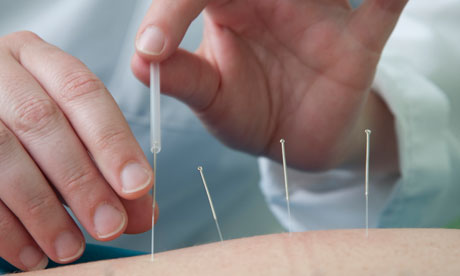
Ever since Chinese doctors first poked their patients with sharp objects 4,000 years ago, and charged them for the pleasure, acupuncture has been shrouded in mystery.
Tradition has it that the procedure works by improving the flow of "qi" along invisible energy channels called meridians, but research published today points to a less mystical explanation for the painkilling claims of acupuncture.
The answer, according to a team of scientists in New York, follows an extraordinary study in which researchers gave regular acupuncture sessions to mice with sore paws.
After each half-hour session the mice felt less discomfort in their paws because the needles triggered the release of a natural painkiller, the researchers say. The needles caused tissue damage that stimulated cells to produce adenosine, an anti-inflammatory chemical, that was effective for up to an hour after the therapy was over.
Modern acupuncture involves inserting fine needles into the skin at specific points around the body. The needles are pushed in a few centimetres, and then heated, twisted or even electrified to produce their claimed medical effects.
Acupuncture has spread around the world since originating in China but conventional western medicine has remained steadfastly sceptical. Although there is now good evidence that acupuncture can relieve pain, many of the other health benefits acupuncturists claim are on shakier ground.
The latest research gives doctors a sound explanation of how sticking needles into the skin can alleviate, rather than exacerbate, pain. The discovery will challenge the view , widely held among scientists, that any benefits a patient feels after acupuncture are due purely to the placebo effect.
"The view that acupuncture has little benefit beyond the placebo effect has really hampered research into the technique," said Maiken Nedergaard, a neuroscientist at the University of Rochester medical centre in New York state, who led the study.
"Some people think any work in this area is junk research, but I think that's wrong. I was really surprised at the arrogance of some of my colleagues. We can benefit from what has been learned over many thousands of years," Nedergaard said.
"I believe we've found the main mechanism by which acupuncture relieves pain. Adenosine is a very potent anti-inflammatory compound and most chronic pain is caused by inflammation."
The scientists gave each mouse a sore paw by injecting it with an inflammatory chemical. Half of the mice lacked a gene that is needed to make adenosine receptors, which are found on major nerves.
The therapy session involved inserting a fine needle into an acupuncture point in the knee above each mouse's sore foot. In keeping with traditional practice, the needles were rotated periodically throughout the half-hour session.
To measure how effective the acupuncture was, the researchers recorded how quickly each mouse pulled its sore paw away from a small bristly brush. The more pain the mice were in, the faster they pulled away.
Writing in the journal, Nature Neuroscience, Nedergaard's team describe how acupuncture reduced pain by two-thirds in normal mice, but had no effect on the discomfort of mice that lacked the adenosine receptor gene. Without adenosine receptors, the mice were unable to respond to the adenosine released when cells were damaged by acupuncture needles.
Acupuncture had no effect in either group of mice if the needles were not rotated, suggesting that the tissues had to be physically damaged to release adenosine.
Nedergaard said that twisting the needles seems to cause enough damage to make cells release the painkilling chemical. This is then picked up by adenosine receptors on nearby nerves, which react by damping down pain. Further tests on the mice revealed that levels of adenosine surged 24-fold in the tissues around the acupuncture needles during and immediately after each session.
One of the longstanding mysteries surrounding acupuncture is why the technique only seems to alleviate pain if needles are inserted at specific points. Nedergaard believes that most of these acupuncture points are along major nerve tracks, and as such are parts of the body that have plenty of adenosine receptors.
In a final experiment, Nedergaard's team injected mice with a cancer drug that made it harder to remove adenosine from their tissues. The drug, called deoxycoformycin, boosted the effects of acupuncture dramatically, more than tripling how long the pain relief lasted.
"There is an attitude among some researchers that studying alternative medicine is unfashionable," said Nedergaard. "Because it has not been understood completely, many people have remained sceptical."
Although the study explains how acupuncture can alleviate pain, it sheds no light on the other health benefits that some practitioners believe the procedure can achieve.
Josephine Briggs, the director of the national centre for complementary and alternative medicine at the US National Institutes of Health, said: "It's clear that acupuncture may activate a number of different mechanisms … It's an interesting contribution to our growing understanding of the complex intervention which is acupuncture."

